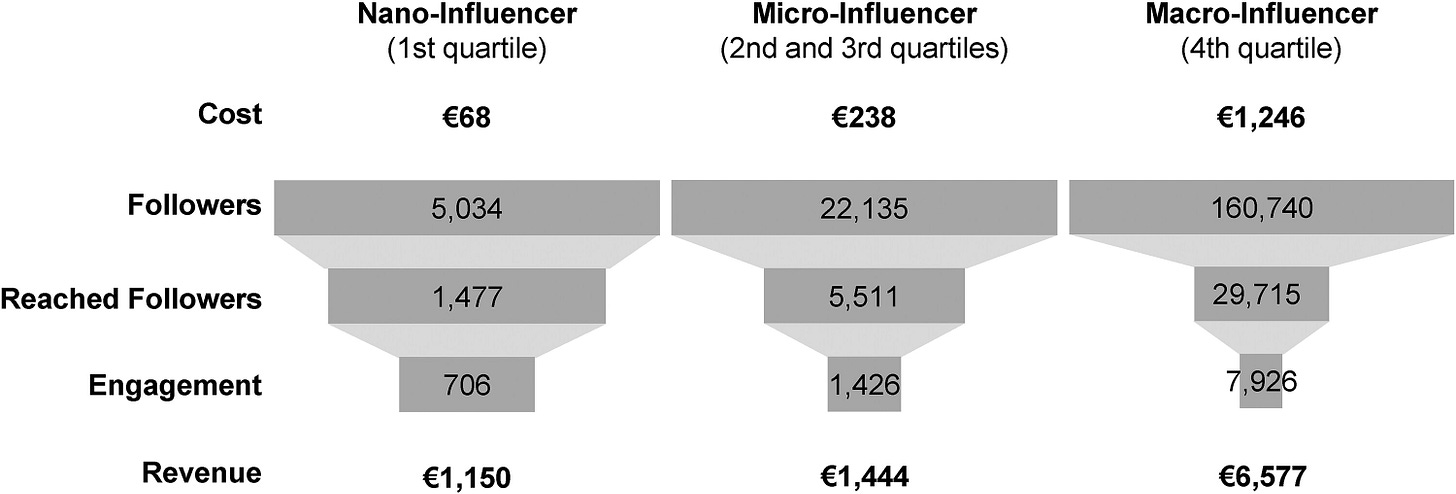Happy Sunday & welcome to your weekly Creator Marketing Update. If you haven’t subscribed yet, please do so below and feel free to share this with your friends & colleagues.
For all of you that speak Dutch (I know you’re out there!) I’m looking for a creator marketing manager to join my Benelux team at air up. If you’re looking - or know someone who is - for a new challenge, enjoy pushing creative boundaries and develop AMAZING content with creators and are passionate about the creator industry, check out the job description below and get in touch.

📈The Long Tail of Social Media Influence
TL;DR
This research paper by Maximilian Beichert, Andreas Bayerl, Jacob Goldenberg, and Andreas Lanz concludes that smaller creators deliver a more efficient return on investment than their more famous colleagues.
HEADLINE QUOTE
“The researchers drew on secondary sales data of 1,881,533 purchases and the results of three field studies with hundreds of paid influencer endorsements. They found that influencers with lower follower counts (referred to as nano-influencers) delivered dramatically better per-follower returns on marketing investments than macro-influencers — that is, those with a high number of followers”
OUR TAKE
I’d highly recommending reading through the research in full, as there are some incredibly relevant insights in there that can be applied by those working in the creator space. I’ve found myself tiring of the “macro versus micro” debate that seemingly bubbles up twice a year - but I welcome this type of academic research, it’s more nuanced and adds context to the conversation.
A widely acknowledged debate is ongoing in the literature regarding the effectiveness of high-followership versus low-followership influencers in user-generated content networks. Yet few articles point out the value of low-followership influencers (e.g., Galeotti and Goyal 2009; Lanz et al. 2019; Watts and Dodds 2007). At this stage, most of the seeding literature in marketing recommends targeting high-followership influencers, that is, hubs (e.g., Goldenberg et al. 2009; Hinz et al. 2011; Leung et al. 2022).
Three different studies have been conducted:
Study 1: Focuses on 319 paid nano- and macro-influencers on Instagram, examining their engagement and revenue generation.
Study 2: Focuses on the efficacy of influencer-specific discount codes shared on Instagram.
Study 3: Supports the results by confirming findings for YouTube and TikTok influencers.
The below graph provides an interesting perspective across the three creator tiers and the delta between costs and performance; with a few caveats.
These results are solely based on IGC featuring discount codes - in order to directly measure revenue.
There is no data available on longer brand partnerships that are full funnel and include multiple pieces of IGC.
The field-research mainly uses Instagram data (+ confirms some of the findings with additional data from other platforms).
Only includes data from the “fashion” vertical.
Not a global study.
Based on this input - I’ve decided to let chatGPT work on a verdict; just to make sure my own biases are excluded.
Conclusion:
Nano-Influencers are highly cost-effective for generating engagement and revenue relative to their cost. They provide the best return on investment (ROI) in terms of revenue and engagement.
Micro-Influencers offer a balanced approach, with moderate costs and reasonable engagement rates, but the revenue to cost ratio is significantly lower than Nano-Influencers.
Macro-Influencers have the advantage of reaching a large audience and have the lowest cost per reached follower. However, they are less cost-effective in terms of engagement and revenue generation compared to Nano-Influencers.
Verdict:
I find that these findings show sufficient potential, and I would recommend sharing this research with your colleagues and have a meaningful conversation around it - and if you work in creator marketing - try to use this data in a way that can benefit you. Hopefully it can help shift perception on how creators across the tiering-pyramid can add value to businesses. One barrier to consider that comes with scaling up a programme that focuses on micro- versus micro: time.
🏭 This week’s must-reads
⚽Why Euro 2024 is ‘a big step change’ for the areas advertisers will rely on
German-headquartered supermarket Lidl’s brand awareness campaign, which is set to run across Europe throughout the tournament on TV, also includes a larger influencer component. Grumbridge told Digiday it’s spending on influencer marketing more than in previous years, though he didn’t share precise figures. “It’s a big step change,” he said.
📈How influencer agencies vet and navigate past fake influencers and followers
In 2021, 49% of all Instagram influencers worldwide had used fake followers at some point, per analytics platform HypeAuditor. The fake following issue was estimated to cost brands some $1.3 billion in 2019 — not a ton of money, but still substantive for what then was a still-nascent business.
✍️ The past, present and future of influencer marketing, according to Taylor Lorenz
Taylor Lorenz, author and tech journalist at The Washington Post, strongly disagrees. As Lorenz said at Sprout’s Under the Brand-fluence digital event, “This just isn’t true. None of the data supports that. That’s a media narrative we hear every few years like clockwork. But over the past two decades it’s just continued to grow. Even deinfluencers influence—they are influencing someone to live a certain lifestyle.”
📲Why You Should Run Your Influencer Marketing In-House
Influencer marketing is not a media buy. It’s not about transactions, but about relationships. It’s not about buying posts and reach, but about establishing partnerships with the right influencers and collaborating on programs that speak to followers in an authentic and compelling way. To achieve this, you must own the influencer relationships and participate in the creative process.
🎙️What influencer marketers are expecting at Cannes this year
“Every year it incrementally gets bigger [for influencer marketing],” Ryan Detert, CEO of marketing company Influential, told us. “This is a breakout year, with the amount of spend being upward of $30+ billion in annual spend in influencer marketing.”



